According to Mississippi’s Department of Fisheries, Wildlife, and Parks over 400 bird species live in Mississippi year-round. Many stay overwinter, so there’s plenty of opportunity to watch our feathered friends when the temperature drops. Here are 26 birds that spend their winters in Mississippi all year round.
1. Blue Jay
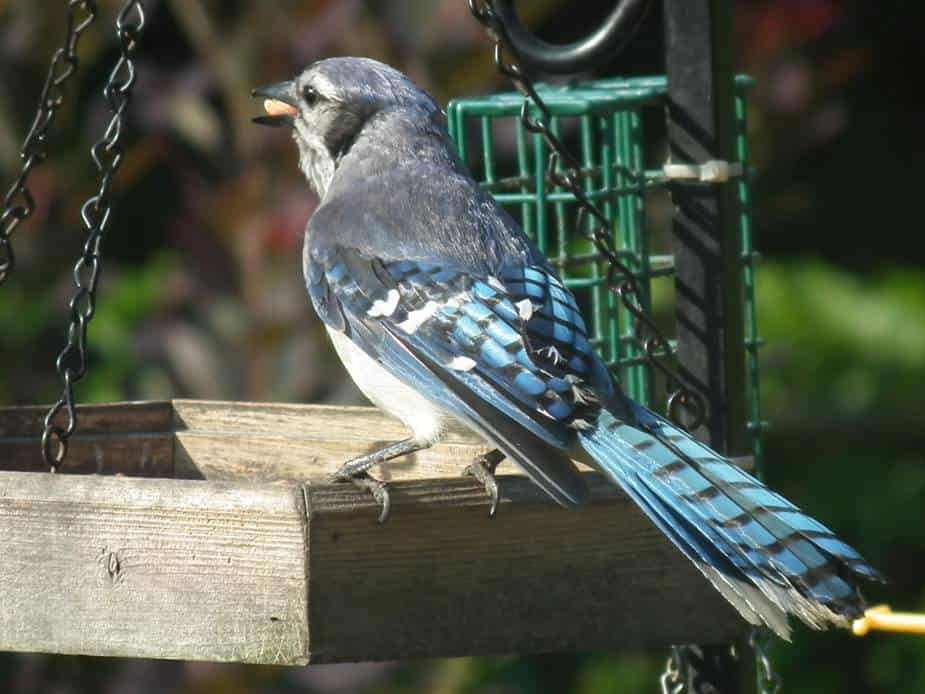
Blue jays eat acorns, insects, and seeds, plus eggs and hatchlings.
©GeoffClarke, CC BY-SA 3.0 – License
Common blue jays have blue upright crests, blue backs, and white undersides. They spend winters in Mississippi, and extra blue jays fly in from northern states.
Clever corvid blue jays live in Mississippi’s forests and backyards where family groups enjoy acorns plus nuts and seeds from feeders. Insects, eggs, and new born chicks form part of a blue jay’s diet, too.
2. Northern Cardinal
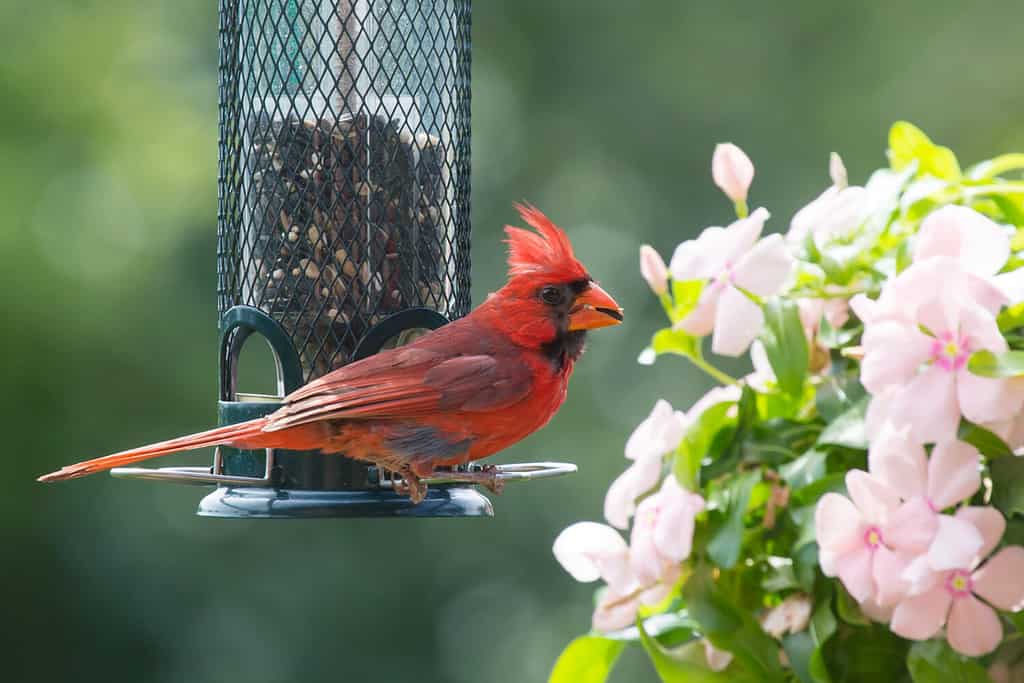
Feisty northern cardinals aggressively defend their nests.
©Ami Parikh/Shutterstock.com
Bright red northern cardinals are hard to miss in winter! This handsome bird forages for seeds, fruit, and insects, and it’s not afraid of confrontation. Northern cardinals will attack their reflections in mating season.
Bright red males are most obvious, but chiefly brown females with red highlights and red beaks add glamor to Mississippi’s winters too.
3. Eastern Bluebird
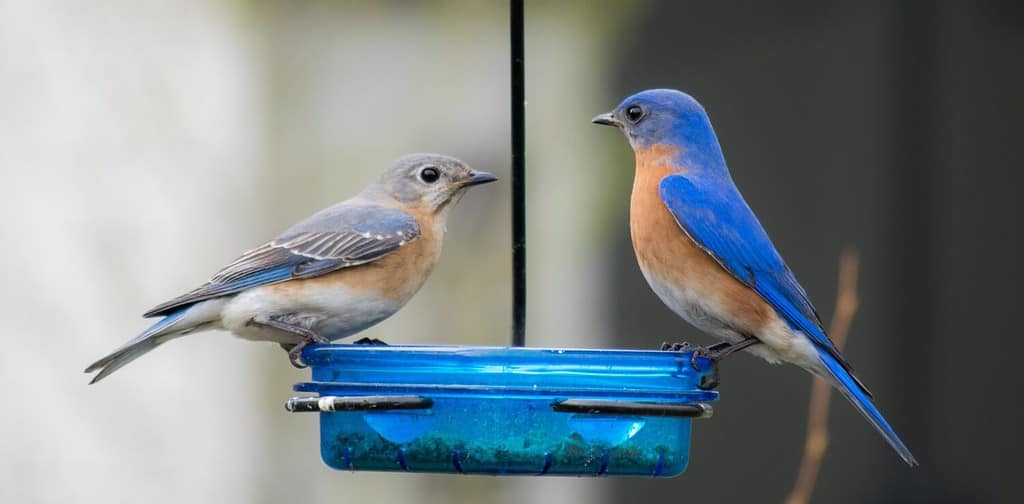
Female eastern bluebirds appear duller than their bright male mates.
©J Zdunczyk/Shutterstock.com
With their big blue rounded heads and big reddish bellies, Eastern bluebirds are a common sight in Mississippi’s winter gardens. Males appear darker blue than the blue-gray females, but they both bring a splash of color.
These small thrushes live year-round in Mississippi’s meadows. They have a penchant for insect spotting on wires, branches, and posts.
4. American Goldfinch
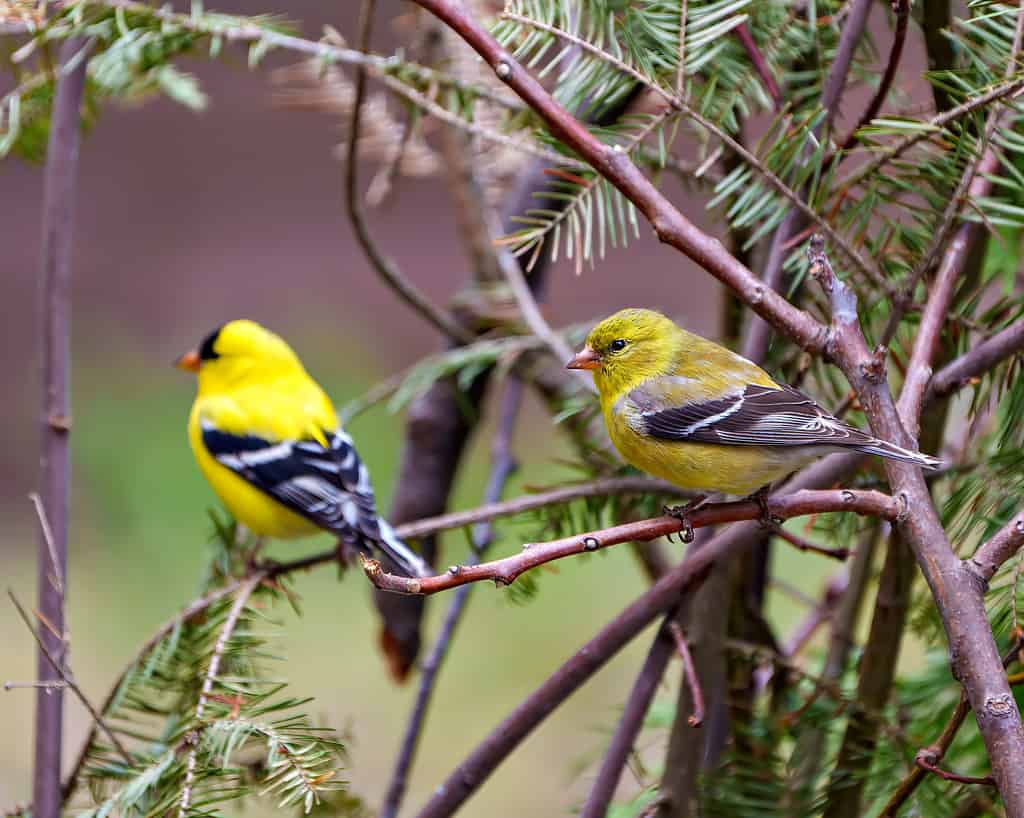
Goldfinches prefer leafy environments that protect them from predators like cats and hawks.
©Rejean Bedard/iStock via Getty Images
Bright yellow and black male American goldfinches, and duller brown females, reside in most of the United States all year round. They enjoy weed-filled open spaces like arable fields and overgrown hedgerows.
A relaxed yard with plenty of leafy cover, plus regular nuts, seeds, and plants, such as sunflowers and asters, welcome goldfinches in.
5. Northern Mockingbird
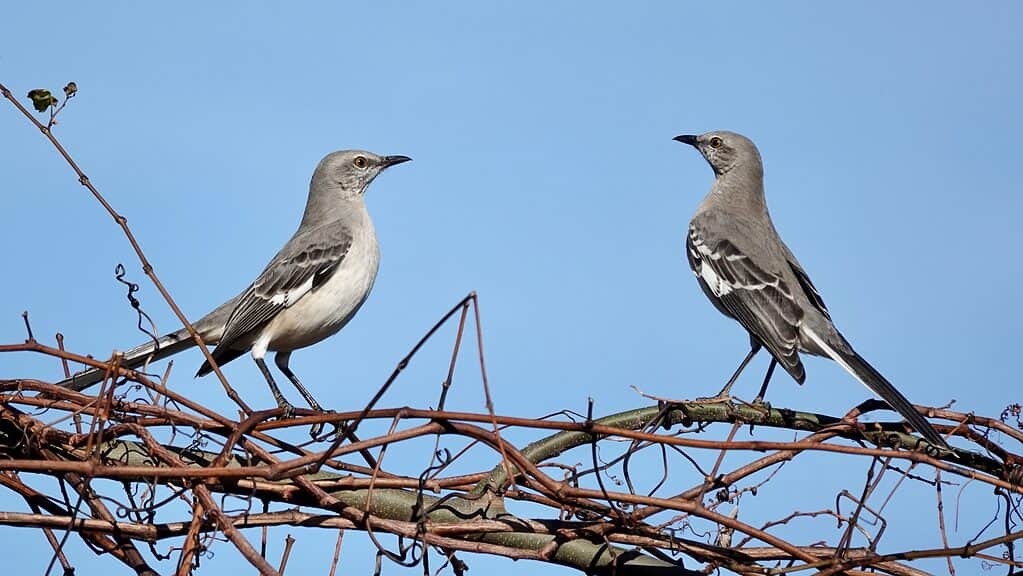
Male northern mockingbirds sing hundreds of different songs.
©Chris Klonowski/Shutterstock.com
Northern mockingbirds have long tails and small heads. Gray-brown in color, with paler bellies and two white stripes beneath their wings, these song-filled birds enjoy open lawn areas. To encourage northern mockingbirds, offer fruit and seeds on open trays.
Did you know that male mockingbirds learn hundreds of song patterns and copy birdsong of other species?
6. Mourning Dove
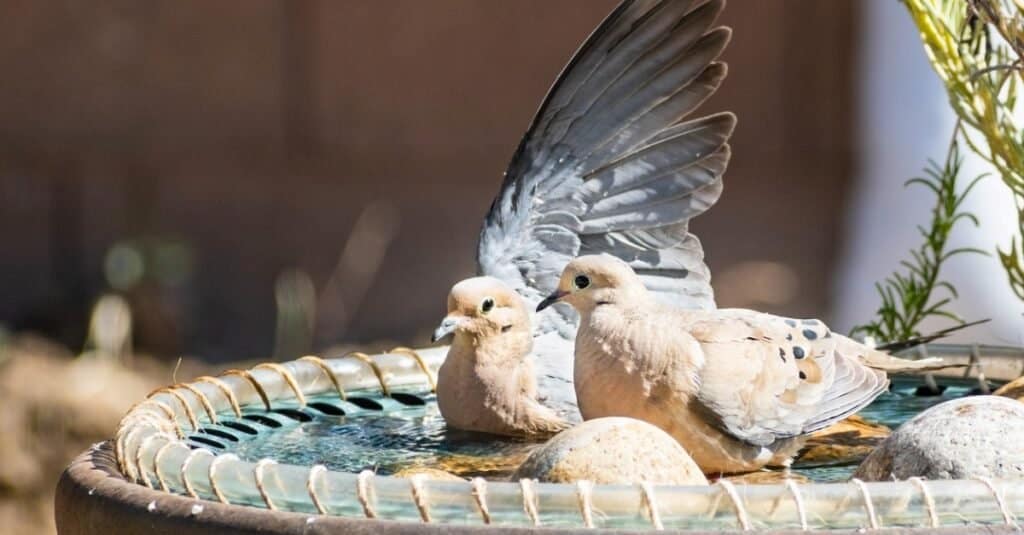
Mourning doves often visit yards in pairs because they mate for life.
©iStock.com/Sundry Photography
Plump and graceful mourning doves appear soft brown with black wing spots. They’ll reach around 9-13 inches long with a small bobbing head.
Mourning doves are common Mississippi winter birds, often spotted on wires or foraging yards and fields for seeds. Mourning doves pair up and stick with their partner for life.
7. Red Bellied Woodpecker
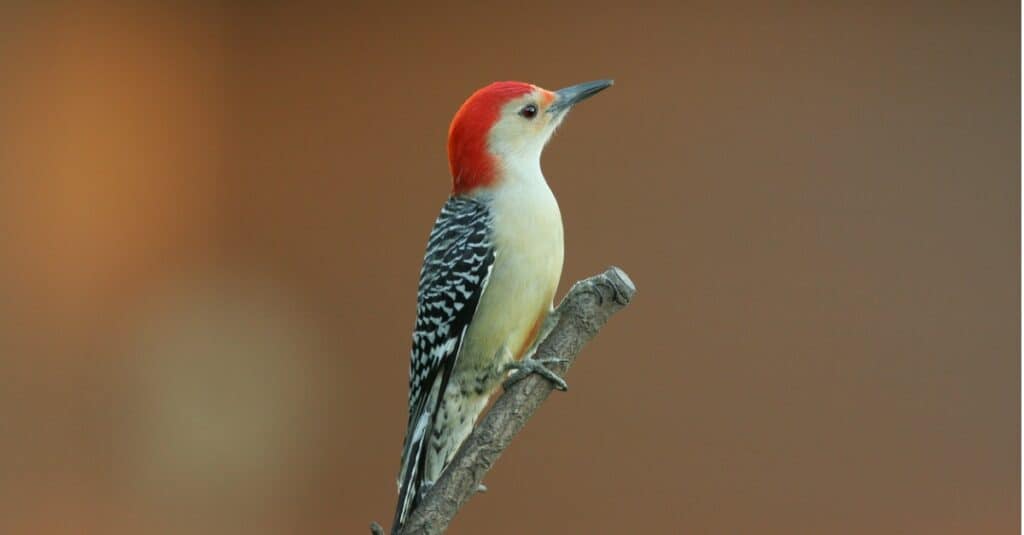
Red bellied woodpeckers have bright red heads and pale red bellies.
©iStock.com/Flatcoater
Small red-belled woodpeckers have pale red bellies and bright red head caps, so they’re often mistaken for red-capped woodpeckers. It’s their much smaller size that gives them away. Red-bellied woodpeckers don’t’ grow larger than 10 inches long and females only have red at the back of their heads.
Woodpeckers eat seeds, fruit, and nuts, plus nestlings, and use their two-inch long barbed tongues and sticky spit to capture insects from cracks and crevices.
8. Carolina Chickadee
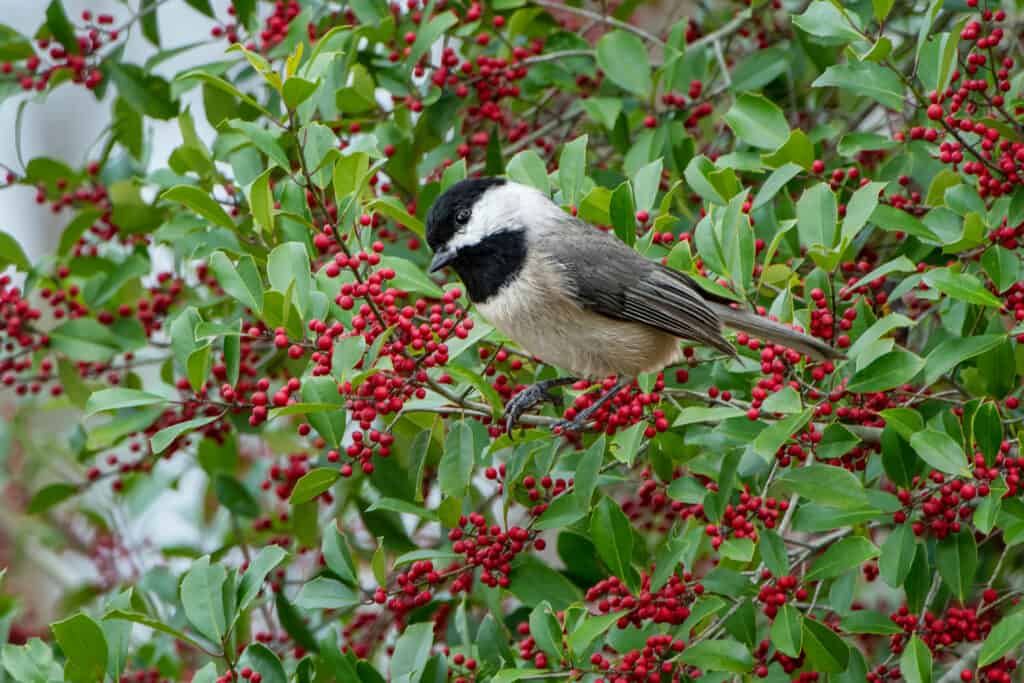
Carolina chickadees forage berries, nuts, and seeds over winter.
©Bonnie Taylor Barry/Shutterstock.com
Tiny Carolina chickadees have gray feathers, black caps, and white cheeks and bellies. They don’t usually grow larger than a diminutive four inches long.
Carolina chickadees spend their winters in Mississippi’s parks, forests, and backyards. They are shy, but know how to take advantage of a seed-filled backyard feeder!
9. Carolina Wren
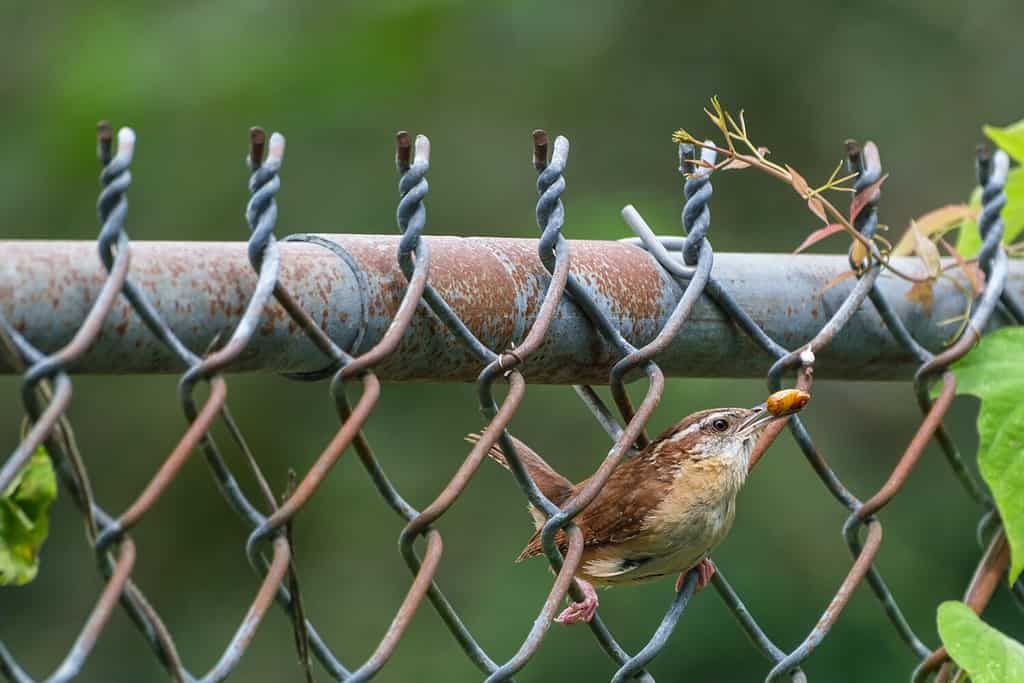
Offer suet, seeds, and nuts to support tiny Carolina wrens over winter.
©William A. Morgan/Shutterstock.com
Another diminutive Mississippi bird is the Carolina wren. Their distinctive round bodies and cute sticking up tail is unmistakable, but these tiny birds are hard to spot because their dark brown feathers camouflage so well. Instead, listen for their “tea-kettle” song.
10. American Robin
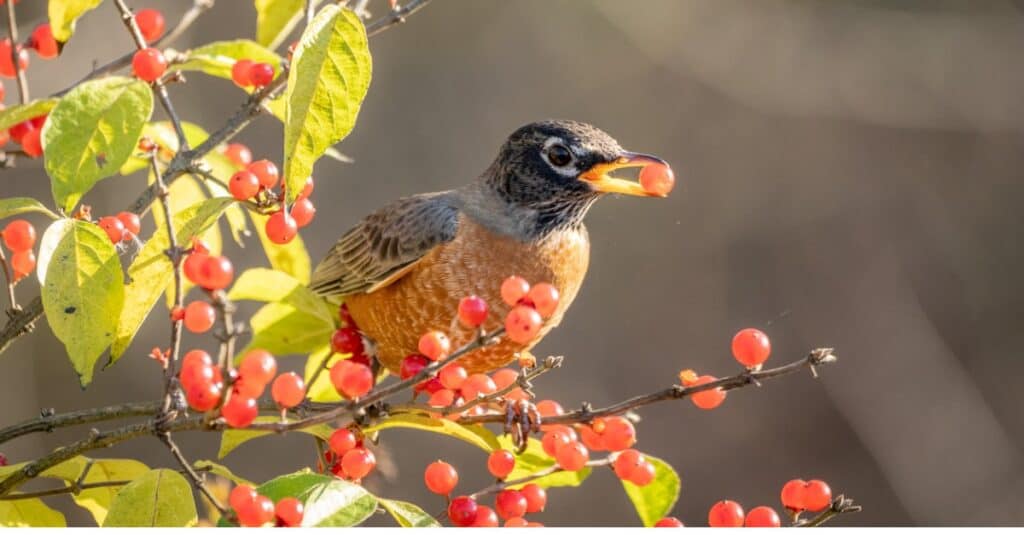
Distinctive red breasted American robins eat insects and berries.
©iStock.com/weaver1234
Common American robins scour backyard lawns for worms, snails, insects, and berries. They have black heads, an orange breast, and generally reach 8-10 inches long.
These iconic birds prefer to stick to tree tops in winter, emerging to forage yards again in spring. Spot American robins in forests, woods, mountains, fields, and parks.
11. Great Blue Heron
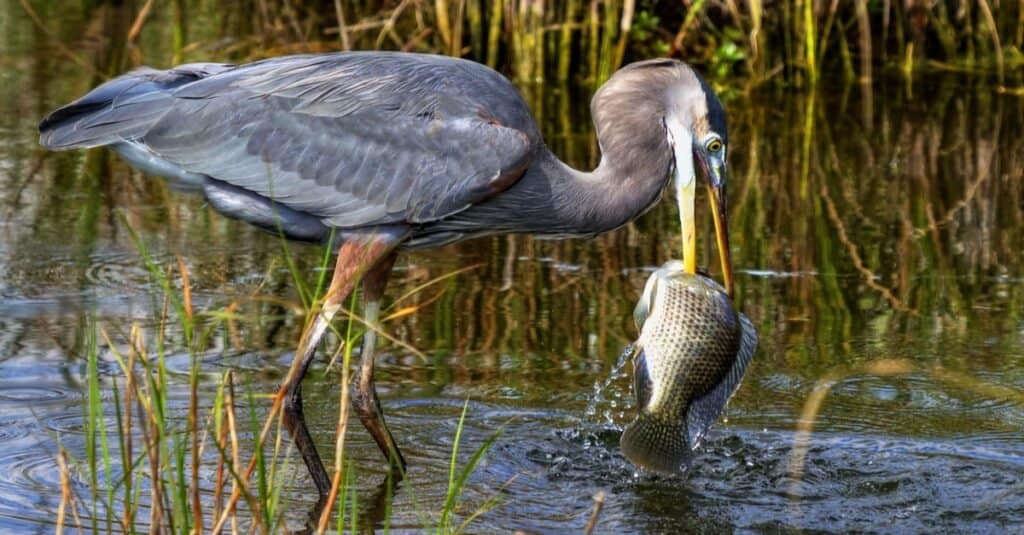
Great blue herons spear fish, amphibians, and crabs with a long, sharp beak.
©David Byron Keener/Shutterstock.com
North America’s largest native heron is the great blue heron. This beauty spends winters in Mississippi’s waters preying on fish, crabs, dragonflies, and amphibians.
It’s easy to recognize this 52-inch-long majestic bird by its long gray neck, crowning black crest, and orange eyes.
12. Red-Winged Blackbird
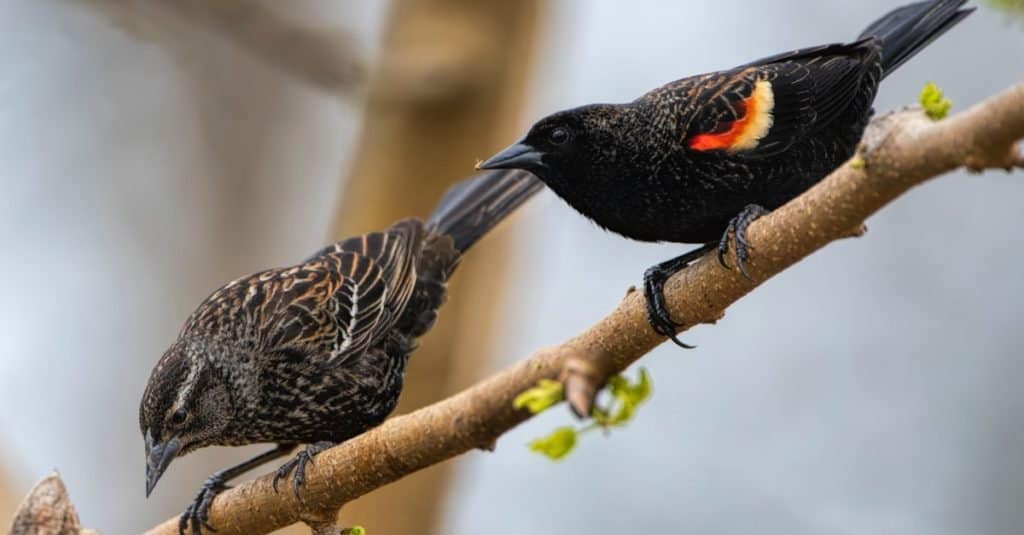
Red-winged blackbird females don’t have the male bird’s distinctive red wings.
©Bonnie Taylor Barry/Shutterstock.com
Millions of common red-winged blackbirds roost together in winter, and during the day they line wires, branches, and rooftops. In spring, males aggressively defend their nests, they’re not against attacking humans that stray too close.
These blackbirds have reddish-orange wing patches and spend their winters in Mississippi’s arable fields hedgerows, and yards. Encourage them to yours with fruit, seeds, and nuts on the ground.
13. Tufted Titmouse
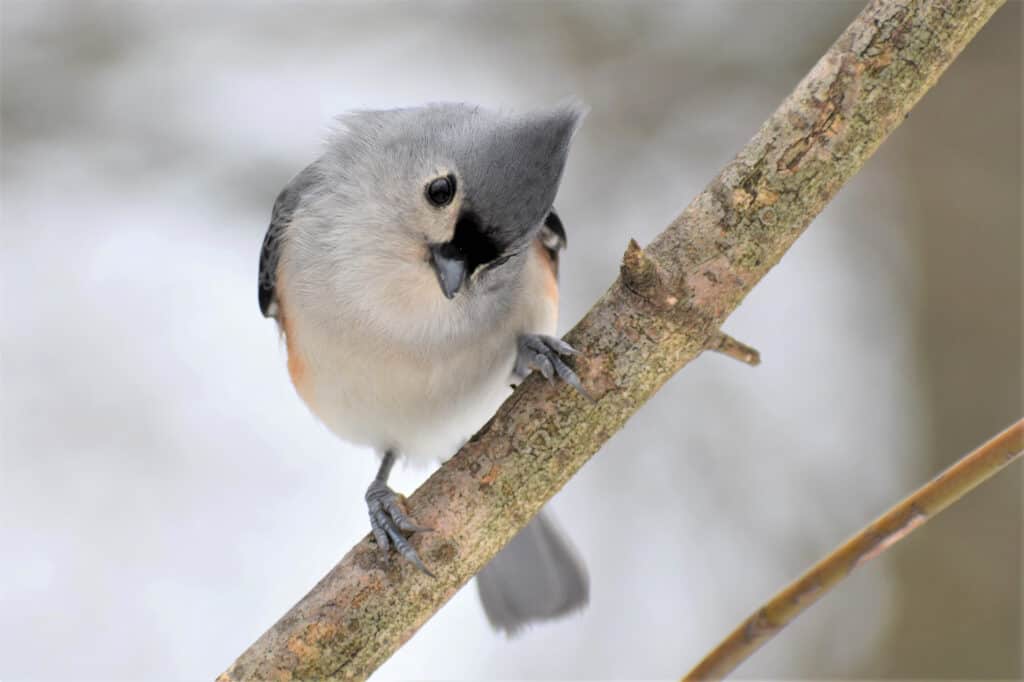
Cute tufted titmouses aren’t afraid to bully other small songbirds at the feeder.
©Lester Graham/Shutterstock.com
A gray and white tufted titmouse has a large crest and big eyes. Cute as a button, this little bird flocks with nuthatches and chickadees.
Around 5-6 inches long, but with a much bigger attitude, tufted titmouses have no problem muscling in on other songbirds’ dinners. They munch down insects including wasps and ants, plus snails too. Encourage tufted titmouses in your garden in winter and they’ll provide pest protection in spring and summer.
14. White-throated Sparrow
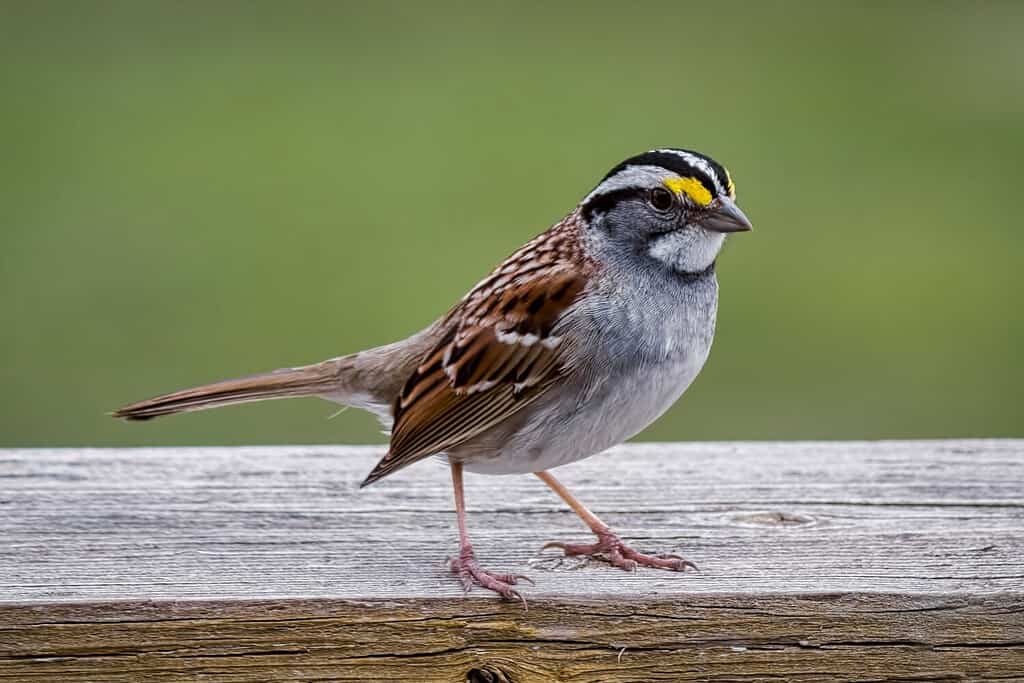
White-throated sparrows nest and roost in hedgerows and eat winter berries.
©Fiona M. Donnelly/Shutterstock.com
With distinctive white and black striped heads, a white throat, and yellow face marking, white-throated sparrows live alongside forests and woodland, where large groups gather in hedgerows to loudly argue.
These pretty birds eat grass seeds and berries, such as dogwood berries. They’ll take insects and enjoy backyard bird feeders stocked with sunflower seeds.
15. American Crow
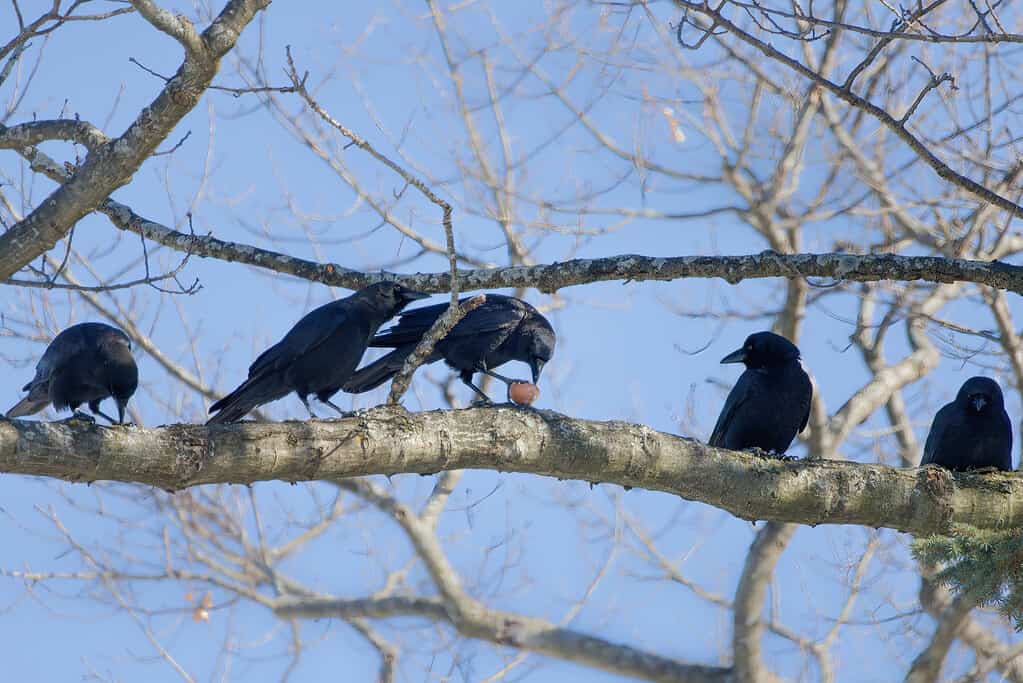
American crows make a distinctive loud cawing noise.
©iStock.com/Karel Bock
15-20 inch long American crows are corvids that inhabit treetops. Their loud caw is unmistakable.
American crows live in Mississippi all year round. They eat most things including seeds and fruit but also mussels, eggs, fish, amphibians, and baby turtles. These large birds can’t resist a trashcan of picnic remains.
16. Double Crested Cormorant
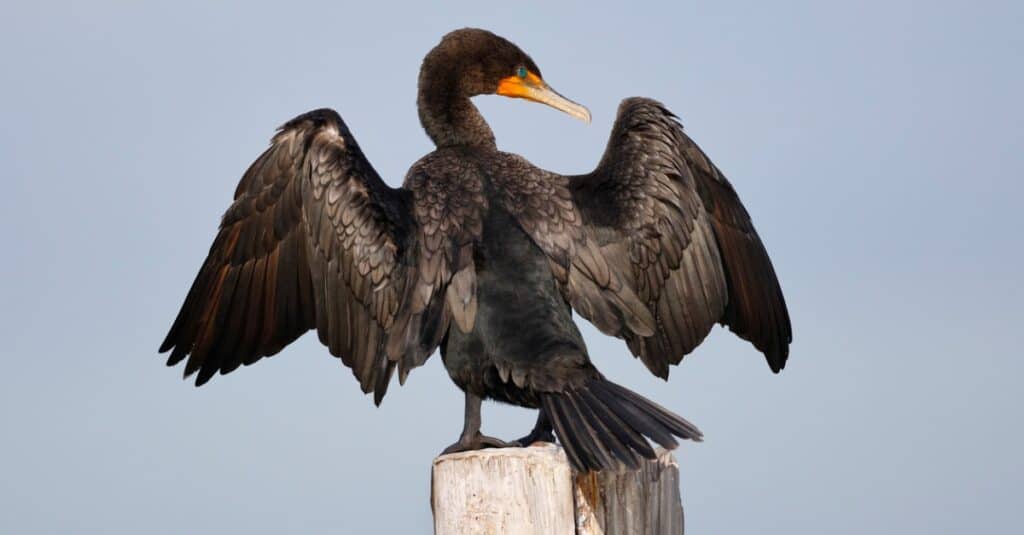
The double-crested cormorant spreads out it wings to dry after diving for fish.
©iStock.com/BrianLasenby
With their damp wings stretched out to dry, double-crested cormorants span reaches 52 inches wide!
These slender water birds have black glossy feathers and bright yellow chins and bills. They’re named for the double-headed crest that appears during breeding season.
Spot double-crested cormorants near swamps, marshes, beaches, and harbors in Mississippi all year round.
17. Eastern Phoebe
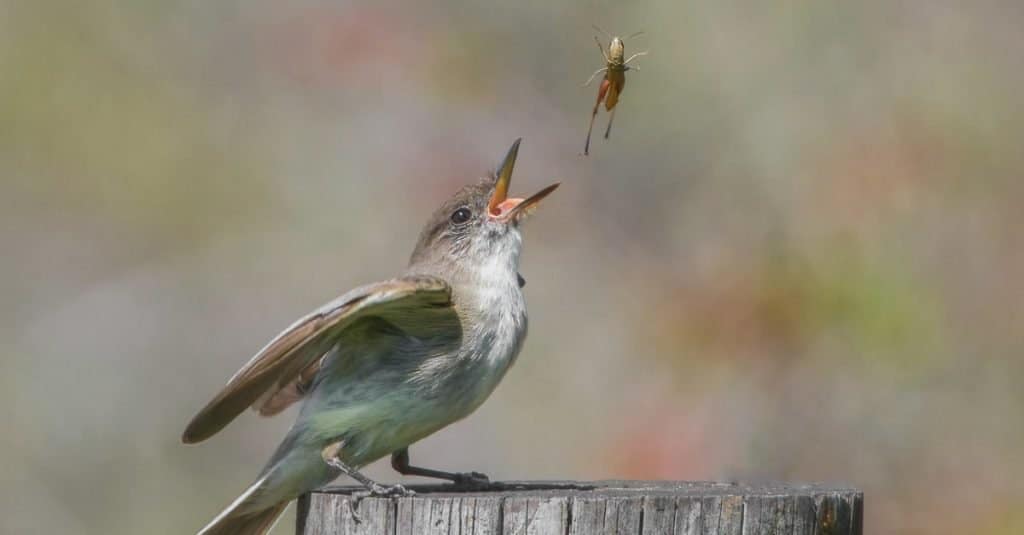
Eastern phoebes eat insects plus seeds or nuts from a backyard feeder.
©Chase D’animulls/Shutterstock.com
Plump and cheerful flycatcher eastern phoebes tend to migrate from North America to the southern counties in winter, but in Mississippi, the winters are chiefly mild enough to stay.
This cute little songbird reaches six inches long, with gray-brow plumage and a white belly. They mainly eat insects, but take seeds and nuts too, so the best way to encourage them is a well-stocked bird feeder with plenty of tree cover.
18. Great Egret
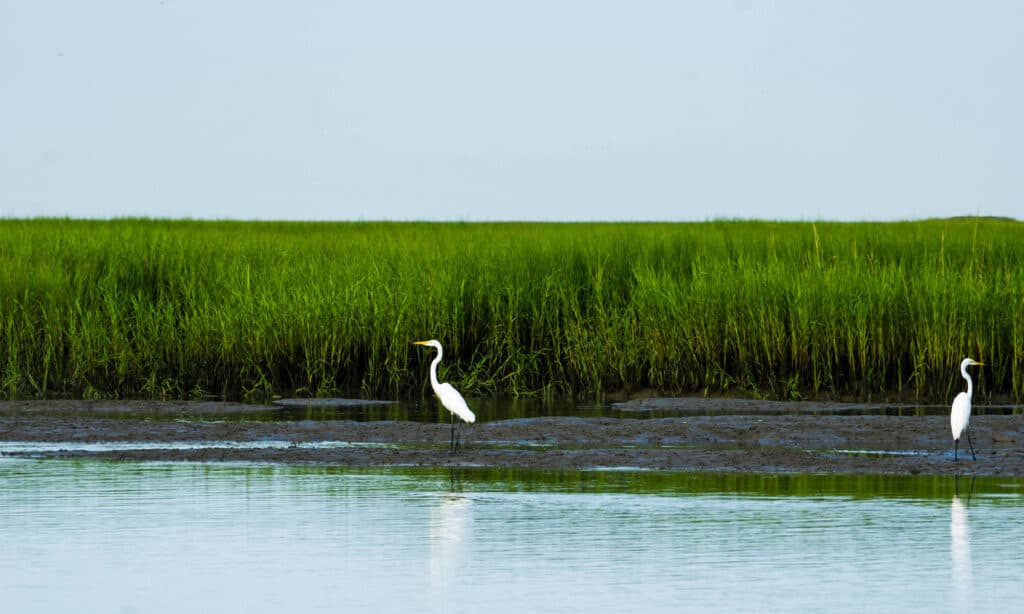
Great egrets wade muddy shorelines and spear their prey with a razor sharp beak.
©iStock.com/makasana
These large white herons brandish sword-like yellow bills and stab muddy shorelines to spear crabs, shrimp, and frog prey. With their long legs, great egrets can wade some distance out, but their bright white plumage makes them an easy spot in Mississippi’s winters.
You might well spot this fairly common bird near your backyard fish pond in winter!
19. Northern Turkey Vulture
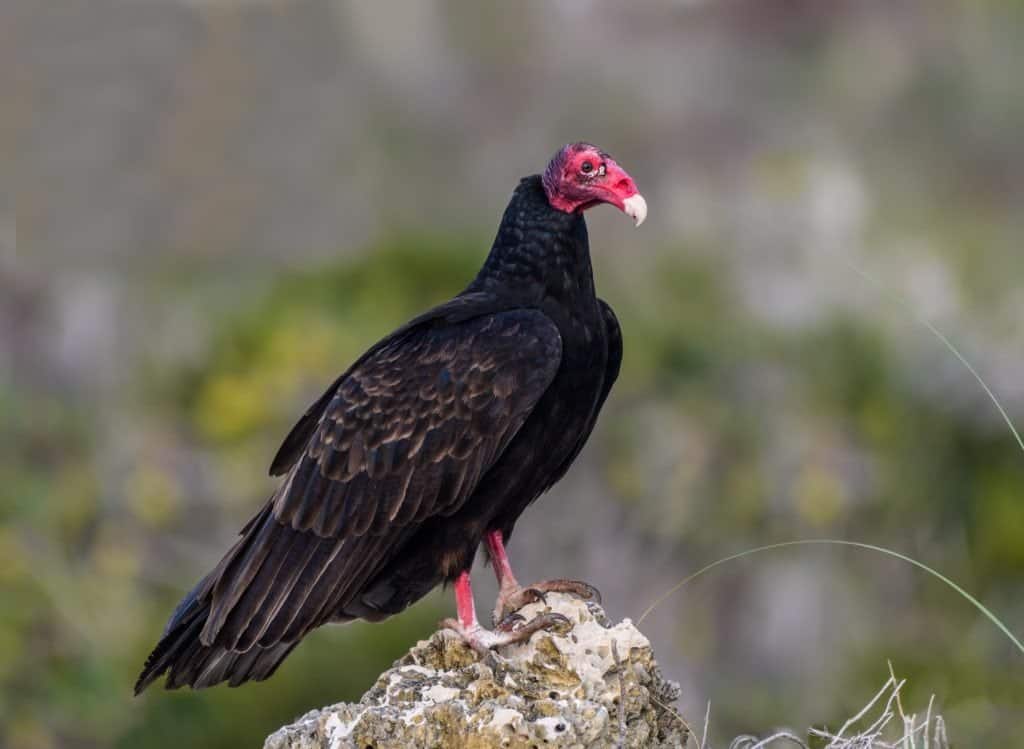
Turkey vultures eat carrion in open grasslands and near woodlands.
©FotoRequest/Shutterstock.com
Venture on a Mississippi winter hike and you’ll no doubt spot turkey vultures. With their brown-black plumage and large red bald heads it’s easy to see how they came by the name.
In flight, these 32-inch-long birds make “V” shapes that distinguish them from other large birds. Find turkey vultures in semi-open areas near woodlands, grasslands, scrublands, and wetlands where they forage carrion.
20. Eastern Towhee

Towhees’ most distinctive feature is their distinctive “chewink” call note.
©John L. Absher/Shutterstock.com
Eastern towhees have bright white bellies, reddish sides, and a black head. Most folks hear them foraging in undergrowth near forests, hedgerows, and thickets before they spot the long tail bobbing up and down.
In Mississippi, some folks call them “chewinks” after their distinctive call.
21. Downy Woodpecker
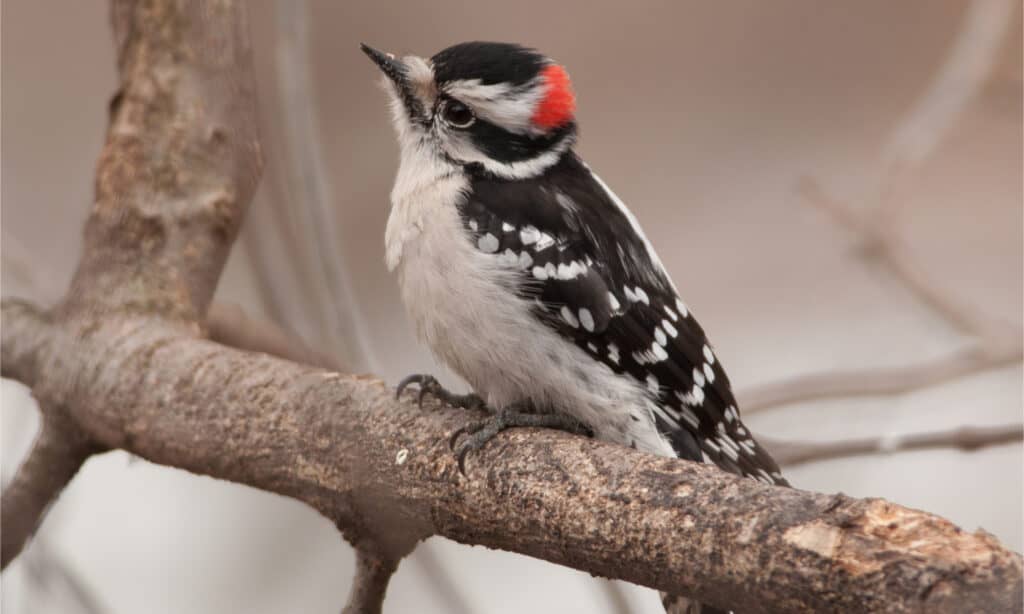
Downy woodpeckers reach 5-7 inches long and often flock with chickadees.
©Gerald A. DeBoer/Shutterstock.com
5-7 inch long downy woodpeckers display typical woodpecker black and white feathers with a crowning red head. They often hang out with small songbirds like chickadees and titmouses.
Downy woodpeckers feast on snails, beetles, insects, and acorns. One of their favorite Mississippian habitats is streamside where they hunt out aquatic insects.
22. Killdeer

Killdeer feign injury to lure predators away from their nests.
©samray/Shutterstock.com
Plover birds with a Lord-of-the-Rings style eye ring! These brown on top, but white beneath, birds have short dark bills and long slender legs.
They forage for insects, snails, worms, and larvae, and cry out “killdeer” as they swoop over farms and scrublands with little vegetation.
Did you know killdeer fake broken wings to tempt predators away from their nests? Clever.
23. Rufous Hummingbird
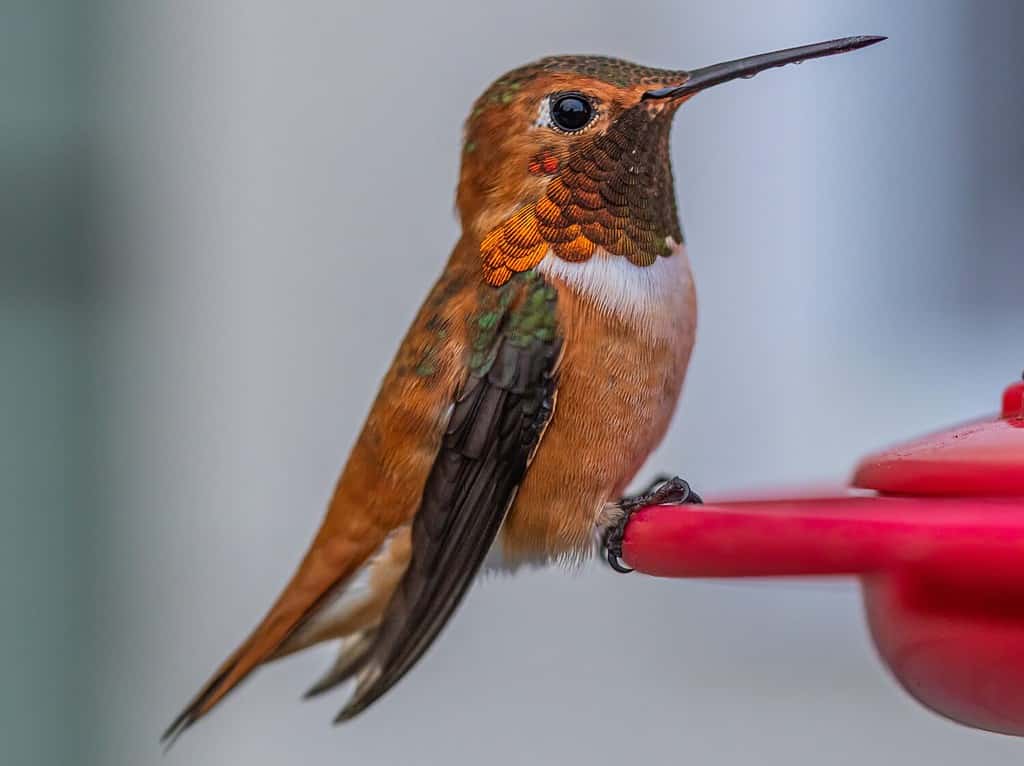
Due to rising winter temperatures, hummingbirds are choosing to stay in Mississippi.
©Panduh Productions/Shutterstock.com
It might sound odd, but due to rising temperatures, hummingbirds are choosing to spend their winters in Mississippi instead of migrating to warmer climates. The rufous hummingbird is a regular spot in recent winters.
Support jeweled hummingbirds with winter flowering bright red and yellow plants and a sugar water-filled hummingbird feeder.
24. American Kestrel
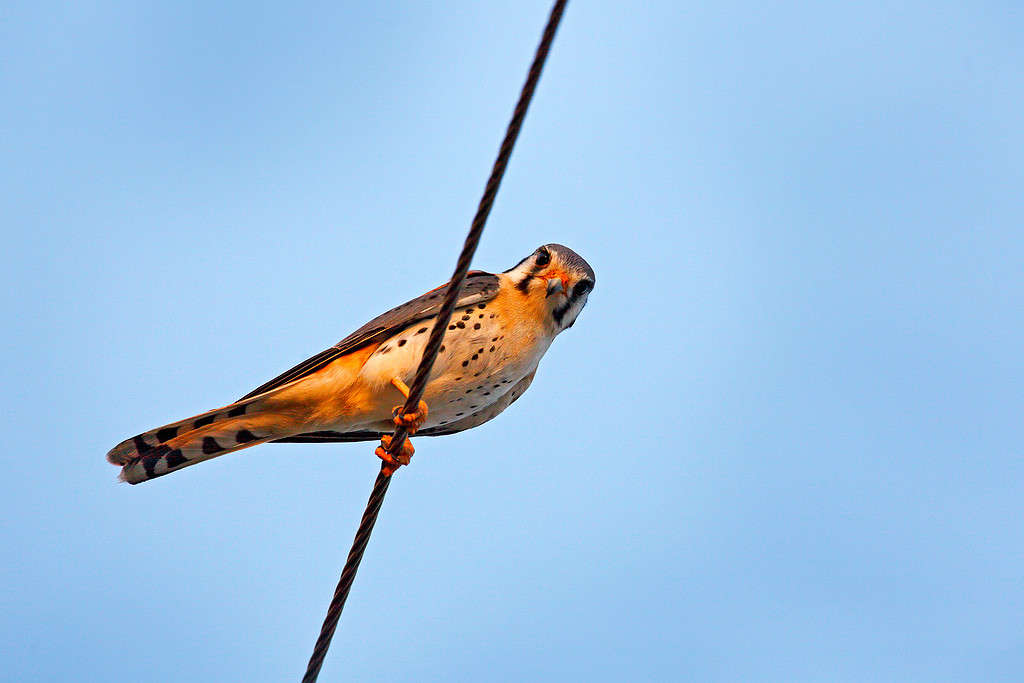
American kestrel is North American’s smallest falcon.
©Ondrej Prosicky/Shutterstock.com
North America’s smallest falcon, the American kestrel, spends its winters patrolling Mississippi’s skies.
Although crows grow larger, don’t be fooled. This small falcon is mighty and more than capable of tackling larger birds that threaten its nest. American kestrels prey on insects, mice, bats, and songbirds.
Spot them hovering above farmland before diving to skewer their prey, or resting on fenceposts and telegraph poles.
25. Brown-Headed Cowbird

Brown-headed cowbirds live on farmland and wooded areas. Females have brown plumage.
©punkbirdr/Shutterstock.com
All year round Mississippi residents brown headed cowbirds enjoy farmland and woodland life. No surprises that this blackbird-sized cowbird has a brown head that contrasts with its jet-black glossy plumage. However, female brown-headed cowbirds are chiefly brown all over.
These unusual-looking birds are brood parasites that lay their eggs in other birds’ nests to swerve all the hard work that parenting brings.
26. Common Grackle
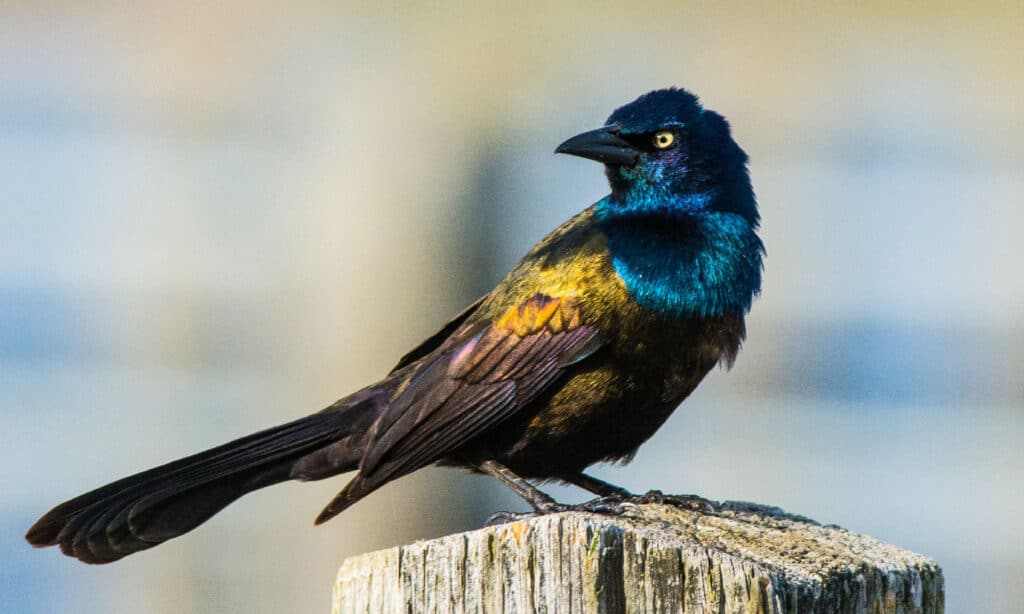
Grackles’ black plumage appears iridescent in bright sun.
©JoshCW Photo/Shutterstock.com
Noisy, but cheerful common grackles descend on lawns in summer to feast on bug larvae and worms, but in winter they tend to forage open fields, and aren’t averse to raiding a bird feeder, either.
Bigger than blackbirds, but smaller than crows, grackles’ iridescent black feathers often ripple purple shades. These chatty birds spend winters in Mississippi chittering and screeching in their family groups, but numbers are in steady decline.
The photo featured at the top of this post is © Matthew Jolley/Shutterstock.com
Thank you for reading! Have some feedback for us? Contact the AZ Animals editorial team.







